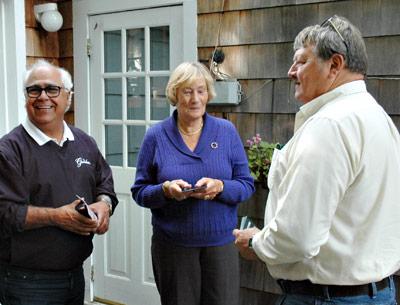Former Hoops Star in Jail Again
Former Hoops Star in Jail Again

Michael Russell, a former East Hampton High School basketball star, is back in jail again, this time facing four felony charges and a possible extended stay in a state prison system, although which state would incarcerate him has yet to be determined.
His latest brush with the law was in East Hampton Village, where, according to police, he went shopping early last month with several credit cards he had taken from an acquaintance, Aisha Ali, a trainer at Stony Hill Stables in Amagansett.
Mr. Russell, 23, known as Mikey, has been in and out of criminal courts and jails across the Northeast. He is facing multiple felony charges in Massachusetts stemming from an alleged armed home invasion robbery and has been convicted of felonies twice before.
According to East Hampton Village Police, Mr. Russell took the cards, which belong to Stony Hill Stables, then used them on Sept. 2 to purchase a pair of Nike Air Pippen sneakers, a pair of Nike Lebron sneakers, and two pairs of Sperry shoes at Sneakerology on Main Street.
When Mr. Russell presented the first two cards to the clerk, a student at East Hampton High School, the charges were declined. The young woman checked with her manager, according to her statement to the police, and the manager, who recognized Mr. Russell, okayed her to run another card, which went through.
The East Hampton Village detective squad identified Mr. Russell as the alleged perpetrator after interviewing Ms. Ali and showing store workers an array of photos. Two workers positively pointed to Mr. Russell as the one who made the purchases, according to police.
East Hampton Justice Lisa R. Rana told Mr. Russell Friday morning that by state law she was not permitted to set bail due to his two previous felony convictions. His attorney, Sheila Mullahy of the Legal Aid Society, told the court that the defendant would waive his right to be released if not indicted after 144 hours, as is required by law.
The most serious of the new charges against Mr. Russell are two felony counts of forgery. He is also being charged with two counts of felony possession of stolen credit cards and two misdemeanor petit larceny counts.
A grand jury heard from witnesses on Tuesday and an indictment could be imminent.
In Massachusetts, Mr. Russell was indicted on March 22 on "four counts of home invasion, three counts of armed assault in a dwelling, two counts armed and masked robbery, armed burglary, armed assault to rob, all of which are felonies, as well as two misdemeanor counts of assault and battery," Paul Jarvey, a spokesman for the Worcester County District Attorney said Friday. He was released on $5,000 bail, on what is called in the state a "pre-trial probation," according to Mr. Jarvey.
The current charges against Mr. Russell "could have a bearing on his bail, which may well be revoked," Mr. Jarvey said.
Mr. Russell was a star at East Hampton High School despite his brushes with the law as a youthful offender. His court records were sealed until he turned 18. In 2008, when he was 18 and had a scholarship awaiting him at Angelina Junior College in Lufkin, Texas, Mr. Russell pled guilty to two burglaries. He had also been charged with breaking into cars and possession of stolen property.
While serving a year's sentence in county jail, he was charged for another crime, one that allegedly occurred before he was sentenced: felony sexual assault in Keene, N.H. The disposition of that case is not known.
Still, given his basketball talents, schools continued to seek him out. On Jan. 27 of this year, he was the leading scorer for the Becker College Hawks, scoring 19 points in a loss to Newbury College. Just hours later, in the early morning of Jan. 28, Worcester police say that Mr. Russell and two other men, all wearing masks, forced their way into an apartment where four students at Worcester Polytechnic Institute lived. One of perpetrators was carrying a gun, police said.
They forced the four male students onto the ground as they went room to room. One of the victims struggled, and pulled Mr. Russell's mask off, police said. That victim later recognized Mr. Russell, who fled with the two still-masked men, according to police.
Several hours later, Mr. Russell was taken into custody in his dorm room at Becker College.







